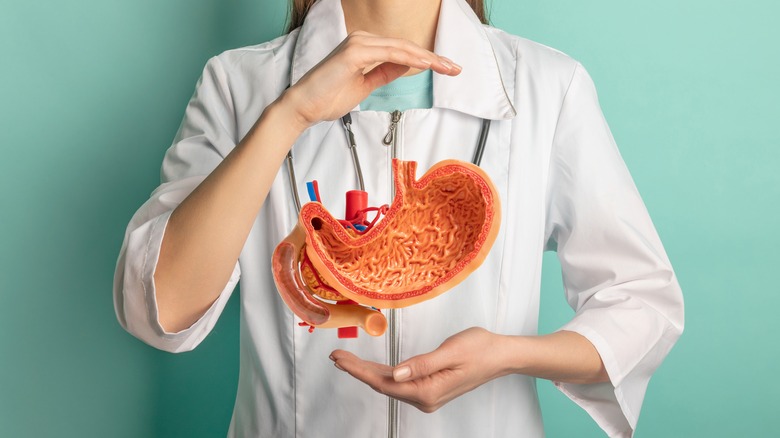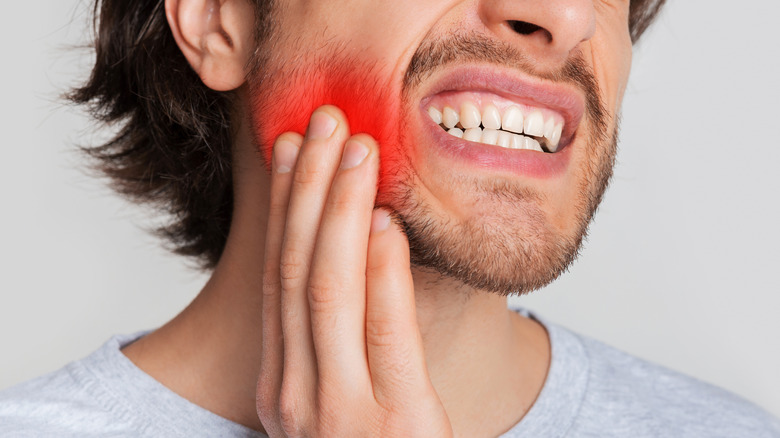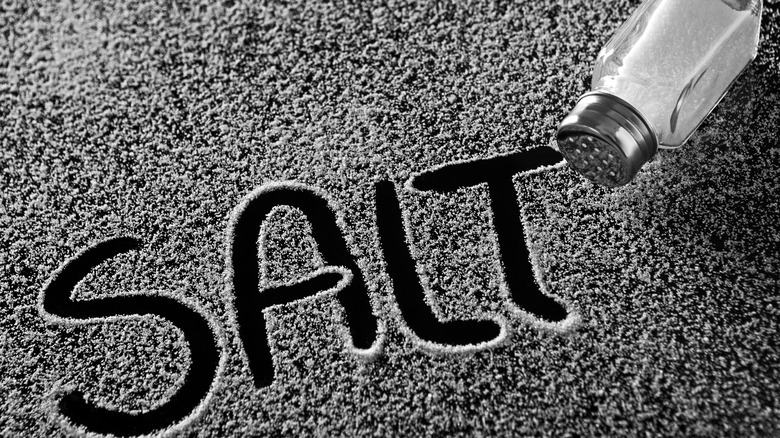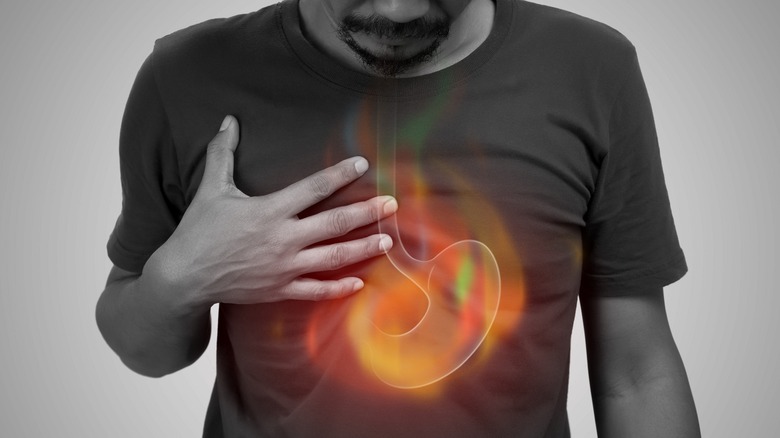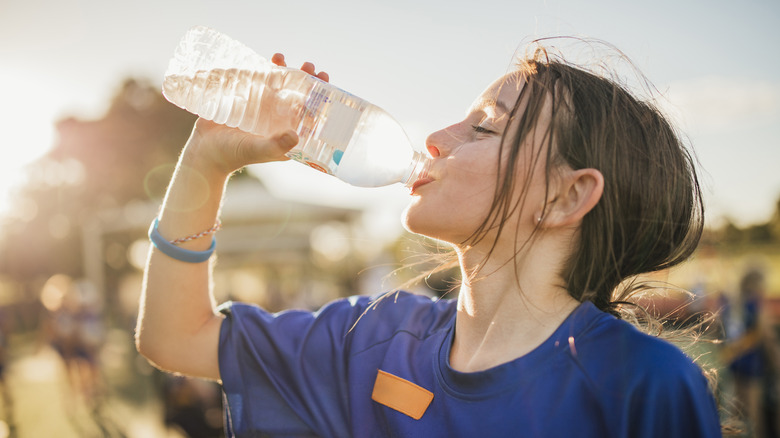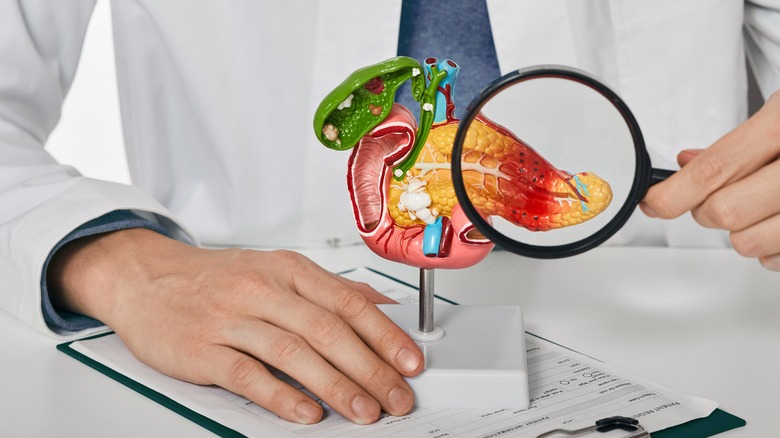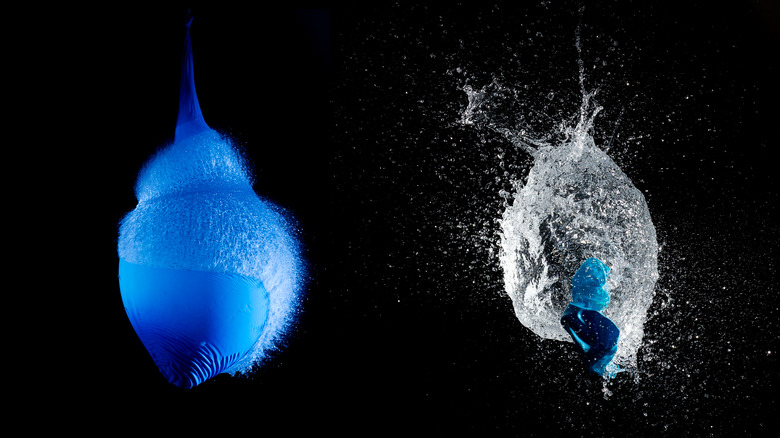What Happens To Your Body When You're A Competitive Eater For A Living
According to an article published in the Canadian Medical Association Journal, what once started as a lighthearted competition to see who could eat the most hot dogs to settle a seemingly innocuous argument between four immigrants in New York City has turned into what you know today as the phenomenon of competitive eating. Nowadays, the rules of an eating contest are simple: to see how much food contestants can eat within a 10 to 12-minute time frame, and competitions are judged by the Major League Eating (MLE), the franchise orchestrating the professional competitive eating circuits (per MLE). Establishing the rules for each gastronomic showdown, MLE oversees a diverse array of food challenges, ranging from hot dogs to shrimp cocktails and buffalo wings to strawberry shortcakes.
Yet, beneath the glitz and glory of these spectacular contests lies a darker truth. The American Medical Association, echoing concerns about the health implications, has denounced competitive eating as inherently unhealthy (via How They Play). Tragically, multiple accounts of deaths linked to complications arising from this extreme form of consumption have underscored the dangers that lurk behind the seemingly harmless thrill of competitive eating. As we untangle the complexities of these gastronomic spectacles, we delve into the potential health consequences that competitive eaters face, shedding light on a world where indulgence takes center stage and the human body bears the brunt of its consequences.
Your stomach could remain permanently stretched out
Repetitive stretching of the stomach to accommodate large amounts of food is a common practice in competitive eating competitions and training, raising concerns about potential long-term damage to the stomach's muscles. As Stack explains, when you prepare to eat, your brain signals your stomach to trigger a process known as "gastric accommodation." During this process, the stomach muscles relax, preparing to accommodate the incoming food. In fact, it is due to gastric accommodation that the average human stomach can increase its gastric capacity, remarkably stretching up to fivefold its normal fasting state while eating, all while returning to its original size once the food passes through the digestive tract.
Nevertheless, gastric capacity seems to be closely influenced by binge-eating behaviors, as observed in competitive eating scenarios. These behaviors go beyond the natural limits of the stomach's stretchability, raising concerns about the potential harm inflicted on the stomach muscles through repetitive stretching. Per an article published in the Canadian Medical Association Journal, as competitive eaters consistently subject their stomachs to extreme expansion, the muscles may endure damage that could result in a permanent state of being stretched out. Therefore, repeatedly stretching the stomach like this can seriously harm its structure and may cause lasting problems.
You may experience jaw problems
As Dr. Gary Lowder, a practicing dentist at the University of Utah School of Dentistry, explained via an interview with the University of Utah Health's The Scope Radio, excessive chewing may lead to inflammation in the jaw joints, potentially resulting in jaw problems such as temporomandibular disorder (TMD). TMD is a condition that usually happens when the joints, ligaments, or muscles around your lower jaw, located right in front of your ear, aren't working as they should. Per Dr. Lowder, regular activities like gum chewing, extended chewing, clenching, or any action that forces the jaw beyond its comfortable position can strain the joint and its muscles, contributing to TMD.
According to Johns Hopkins Medicine, TMD manifests as discomfort or soreness in the jaw, especially noticeable in the morning or late afternoon. Other symptoms of TMS include clicking or popping sounds in the jaw, jaw locking, limited mouth movements, teeth clenching or grinding, dizziness, headaches, pain around the eyes, face, shoulders, neck, and back, as well as earaches or ringing in the ears. In the context of competitive eating, where participants engage in prolonged and intense chewing, the repetitive strain on the jaw joints and associated muscles, coupled with the extreme nature of the activity, can significantly increase the likelihood of developing TMD.
You may develop obesity in the long run
With its extreme focus on rapid consumption and pushing the body's limits, competitive eating poses a potential threat to the body's natural satiety reflex, a key internal mechanism for maintaining a healthy weight. According to a 2022 study published in the International Journal of Environmental Research and Public Health, this internal regulation system is responsible for recognizing physical cues of hunger, appetite, and fullness, helping regulate the amount of food consumed to support a stable body weight. However, if said internal regulation is compromised, you may struggle to identify sensations linked to hunger and satiety. As Stack explains, when you eat, the stomach sends signals to the brain when it reaches a certain point of fullness, signaling that it's time to stop eating. However, this natural neural reflex weakens in the world of competitive eating, where the norm is binge eating and surpassing the point of satiety.
In fact, in a study published in the American Journal of Roentgenology, researchers interviewed a speed-eating champion, who revealed the extent to which training for such competitions can alter their satiety reflex. The study discovered that these champions, driven to consume larger quantities of food at high speed, intentionally override the signals of fullness and satiety during their training. Over time, their stomachs can stretch so much that the sensation of being full is lost, which comes with significant consequences, seeing that they may find themselves incapable of experiencing the usual feelings of fullness and satisfaction after a meal. Therefore, the risk of developing obesity and associated health issues becomes substantial in this scenario.
You might consume too much sodium
The prevalence of junk food in eating competitions introduces a notorious health concern, particularly in relation to sodium intake. According to the American Heart Association (AHA), more than 70% of sodium in diets comes from processed foods, and the sheer quantity of such foods consumed during competitive eating events and training periods is enough to raise alarms about potential health risks.
In fact, the AHA recommends a daily sodium intake of no more than 2,300 milligrams. However, the reality is that the average American (who is not a competitive eater) consumes over 3,400 milligrams of sodium daily, well exceeding these recommended limits (now imagine how much more these athletes might ingest in one sitting). What's more, eating contests organized by the MLE often feature common high-sodium foods like shrimp, pizza, sandwiches, processed cheese, hot dogs, and bagels (per MLE). Thus, the cumulative impact of consistently high sodium intake can be detrimental to a competitive eater's health, leading to a myriad of health issues, ranging from headaches and kidney disease to osteoporosis, stroke, heart failure, high blood pressure, kidney stones, and even stomach cancer (via AHA). Therefore, it is essential to recognize the potential health consequences of the dietary choices associated with competitive eating, emphasizing the need for awareness when managing sodium intake to safeguard long-term health.
You may experience digestive issues
Chugging down food without adequate chewing not only hampers the digestive process but also poses the risk of various digestive issues. Digestion is a crucial process for nutrient absorption that involves both the mechanical and chemical breakdown of food. Mechanical digestion physically breaks down food into smaller particles (think chewing), while chemical digestion finishes the job by degrading these particles into absorbable forms with the help of digestive enzymes, via the National Library of Medicine (NIH). However, as competitive eaters prioritize speed over chewing efficiency, they inadvertently expose themselves to the risk of disrupting the delicate balance required for effective digestion, which can lead to nutritional deficiencies and gastrointestinal problems.
On the one hand, the NIH explains that the stomach only allows particles smaller than two millimeters to pass into the small intestine for further digestion and absorption, meaning that poorly chewed foods will have a harder time making the cut and will place an additional burden on the stomach. On the other hand, a review published in Food Science and Nutrition explains that when food particles are not adequately broken down, fragments that are too large to be digested completely may reach the large intestine, promoting bacterial overgrowth, which can result in uncomfortable gastrointestinal symptoms such as indigestion, bloating, and constipation. In addition, studies have shown that inefficient chewing is also associated with a higher risk of irritable bowel syndrome, further highlighting the importance of proper mastication in maintaining digestive health.
It may lead to water intoxication
Per the American Council of Science and Health (ACSH), many competitive eaters rely on an unconventional method to both train their stomachs and push down the colossal amounts of food they consume during contests: guzzling gallons of water. While this practice is considered a secret to success in speed eating, it can lead to a potentially lethal condition known as "water intoxication." Water intoxication or water poisoning occurs when an excessive amount of water is consumed within a short period, causing a rapid drop in sodium levels in the blood (via the NIH). This drastic reduction in sodium can result in severe consequences, including brain swelling, stroke, coma, and, in extreme cases, death. The symptoms of water intoxication range from head pain, muscle cramping, spasms, and weakness to nausea, vomiting, drowsiness, and fatigue. In more severe instances, it can lead to seizures or loss of consciousness (per Healthline).
A tragic incident in 2007 serves as a heartbreaking reminder of the dangers associated with excessive water consumption during competitive eating. While participating in a radio station's water-drinking contest, Jennifer Strange drank two gallons of water and finished in second place, according to ABC News. Regrettably, shortly after, she succumbed to acute water poisoning. The practice of drinking copious amounts of water highlights the need for caution and awareness about the potential risks of such extreme behaviors in competitive eating.
You may develop acute pancreas damage
Acute pancreatitis stands as the primary cause of gastrointestinal-related hospitalizations in the U.S. (via the NIH) and, according to a study published in Gastroenterology, overeating, especially when it leads to stomach distention (as seen during eating competitions), can contribute to the development of acute pancreatitis. The condition refers to the sudden inflammation of the pancreas, an organ that's located behind the stomach and near the small intestine and that plays a crucial role in producing and distributing insulin, digestive enzymes, and essential hormones. Its symptoms are characterized by pain in the upper abdomen accompanied by fever, nausea, vomiting, a swollen or tender belly, and tachycardia or an elevated heart rate (via Healthline).
Per the study, which reviewed the case of a competitive eater, one potential trigger for acute pancreatitis is the rapid and excessive stretching of the stomach resulting from the consumption of insufficiently chewed food. This leads to the accumulation of large chunks of solid food in the stomach, blocking their passage into the duodenum (the first part of the small intestine). Moreover, the effect caused by the distended stomach worsens the situation by squeezing the duodenum further. While more research is needed to validate the claim, researchers believe this compression and blockage of the duodenum is what could have caused the onset of acute pancreatitis.
Your stomach can burst
Eating competitions are, in essence, binge-eating contests, and research has linked fatal outcomes resulting from extreme acute stomach stretching after binge-eating episodes, suggesting an association between massive food intake and extreme consequences such as perforation of the stomach wall. According to a case report published in Northern Clinics of Istanbul, a patient who consumed an excessive amount of grapes and pomegranates suffered from excessive stomach distention caused by the marked increase in stomach contents, which ultimately caused it to burst. The amount of food raised the patient's abdominal pressure, potentially reducing blood flow within the stomach walls, which increased the risk of death of the stomach's tissue, leading to perforation.
As Dr. Rachel Vreeman explained via NBC News, under usual circumstances, the stomach can comfortably accommodate about one to one-and-a-half liters of food or liquid before causing nausea. Nevertheless, stomach rupture seems to happen when people try to consume around five liters of food or fluid. The process leading to stomach rupture involves the stomach's walls facing increased pressure from the growing volume of contents. This pressure weakens the stomach tissue, eventually causing it to tear. However, to reach the rupture point, people must go past the nausea reflex (which would help empty the stomach's content through vomit), and this is something that competitive eaters train to do. So, by disrupting their body's natural reflexes, over time, when the stomach becomes extremely distended, the stretched-out muscles lose their strength, making it difficult for the body to throw up the excessive food, thus increasing the risk of bursting.
It may lead to esophageal damage
Overeating, especially in the context of competitive eating, can exert considerable pressure on the esophagus (the tube that connects the throat to the stomach), potentially resulting in tears or even rupture. A study on competitive eating published in the American Journal of Roentgenology revealed that as food progression into the stomach is hindered by the amount of food already consumed, it starts to accumulate in the lower part of the esophagus, intensifying the pressure on this vital passage. In fact, an article published in the Canadian Medical Association Journal lists Mallory-Weiss tear and Boerhaave syndrome as potential complications of repetitive and excessive food binging, a common practice in competitive eating.
Mallory-Weiss tears involve the splitting open and bleeding of the inner lining of the esophagus, occurring where the esophagus meets the stomach. The general consensus is that elevated abdominal pressure forces stomach contents into the esophagus, leading to these tears (per the Cleveland Clinic). In contrast, Boerhaave syndrome, a less common yet severe condition, is characterized by a hole or tear that goes through all the layers of the esophagus, also linked to an increased pressure exerted on the esophagus during bouts of overeating, which can have fatal health outcomes (via the NIH). As competitive eaters push their limits, it becomes crucial to recognize and address the risks posed to the esophagus, minimizing the potential for severe complications.


